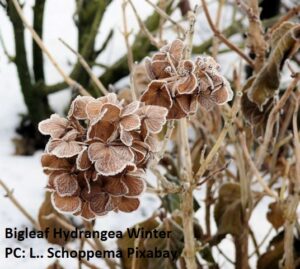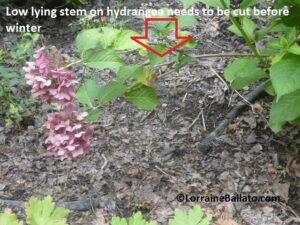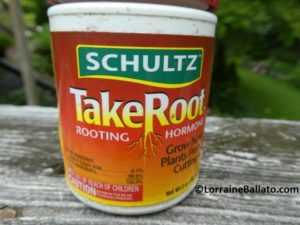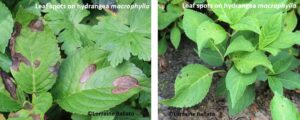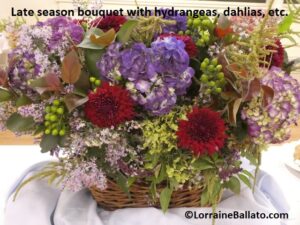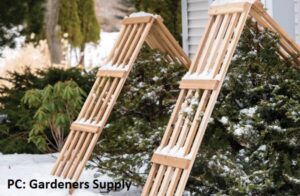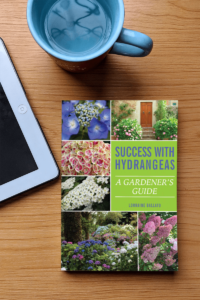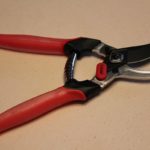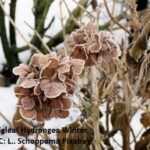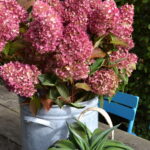For gardeners in the Northern hemisphere, we are coming into the home stretch for considering autumn hydrangea care. Where I garden in US Zone 5b, we are almost out of time by mid-August. But if you garden where it is warmer, you have a few more weeks. Here’s what to keep in mind.
THE SCIENCE YOU NEED TO KNOW
If you fool around with your plants too late in the season, you risk distracting them from 2 important tasks. First, your big leaf (macrophylla) and mountain (serrata) plants start to make next year’s flowers under 2 conditions: nights consistently below 60 degrees, and short day length (after June 21 in the Northern hemisphere). We are on the cusp of those cooler nights (thank heavens!) so bud set is right around the corner. The second thing that your plants need to do is settle down to go into a dormant state.
So if you prune, fertilize, etc. now you will stimulate them. They will put their energy into developing new growth (which might not survive their coming dormant period), and you will distract them from their main job of setting up next year’s flowers before they enter their rest period.
A FEW LAST THINGS TO DO
What you can do now is finish up any cutting you need to do. I am very cautious about deadheading this late in the season. Those spent flowers serve a useful purpose as umbrellas to protect sleeping flower buds in the stems over the winter. They can also be interesting focal points in your winter garden as they catch the ice and snow.
CUT LOW LYING STEMS
What I usually cut this late in the season are low-lying stems that are growing sideways.
Since I live in a snowy climate, it’s a sure bet that those stems will get pulled down even further and probably break under the weight of the ice and snow. Rather than risk causing damage to a plant, I simply remove the stem.
MAKE MORE PLANTS
If you want to make more plants, you can gently bring these low stems down to make contact with the ground. Wound it slightly on the side that touches the ground and sprinkle some rooting hormone on the cut.
Bury the cut and hold it down with a rock or maybe a ground staple or two. Next spring you should have roots at that cut which can then be severed from the mother plant. Voila! Another hydrangea for your garden.
REMOVE DEAD STEMS
I also cut out any dead stems that have developed during the season for one reason or another. They are so easy to spot now and will make my spring clean up much easier.
SET YOURSELF UP TO START CLEAN NEXT SEASON
The other thing to do in autumn is check on your plants’ disease condition. Do the leaves have spots on them? Look closely and you’ll probably find spotted leaves at the base of the plant and sometimes deep inside the foliage.
With a gloved hand, physically remove each and every one of them and disinfect your gloves/tools as you move between plants. Know that fungal/foliar spores winter over and will reinfect your plant next season when the conditions are right.
Once you have cleaned the foliage and trashed it, replace the mulch as the fungal spores can hide there as well. Do NOT compost it — it’s trash. This is part of your plan for next year to start clean so you can stay clean in 2024.
CUTTING FLOWERS FOR BOUQUETS
Go ahead and cut flowers for bouquets. But do it soon. That cutting will stimulate your plant which you don’t want to do once the conditions are right for bud set.
GET MATERIALS READY TO WINTERIZE/WRAP YOUR PLANTS
While it is still comfortable to work outside, get organized to protect your plants this winter. You can gather your materials, and make your plan so that when the moment arrives, you will be ready. You might decide to make a “cage” that you then stuff with straw, leaves, etc.
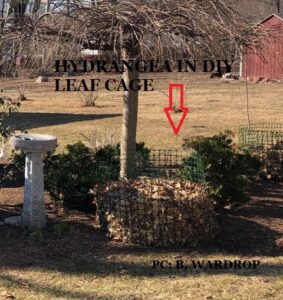
Big Leaf hydrangea encased in leaves for the winter
Or maybe you need to create a protective barrier to shield your plants from the ice and snow that might come your way.
In any event, take the time to pull things together in the next few weeks to protect your plants.
UPCOMING TALKS
I am booking talks for this fall and into 2024. If your group is interested in joining the fun, be sure to use the “Contact Lorraine Ballato” option. I deliver both live and virtual talks these days so geography is not an issue. I’d love to meet you!
REVIEW REQUEST
Fortunately, book sales have continued to be brisk for which I thank you. If you haven’t already done so, I would appreciate your adding a review on your favorite book site. Reviews help others make their buying decision and help me sell more books. That in turn helps other hydrangea lovers get the most from their plants. It’s a win-win for everyone.
THANKS FOR READING
6 Secrets for Stunning Hydrangea Flowers
Get my FREE mini-guide with 6 fool-proof tips showing how to grow hydrangeas that produce the most amazing flowers.
No spam - I promise!
